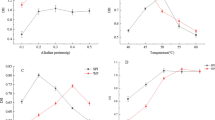Abstract
Protein-based viscous gels can augment or replace carbohydrate-based ones for specific nutritional formulations such as in reduced calorie or low-fat food applications. In this study, slurries of whey protein isolates and calcium caseinate mixed with alginic acid (20% T.S.) were subjected to high-shear homogenization (microparticulation) at 27,000 rpm for 2, 3, 4, and 6 min. The resulting slurries were incubated with mushroom tyrosinase (E.C. 1.14.18.1) at levels of 3, 6, and 9 mg/100 g for 15, 30, and 60 min to facilitate gel formation of the alginic acid with the homogenized dairy proteins. The results indicate that the time of high-shear homogenization had significant (P < 0.05) effect on the viscosities of the gels. Highest gel viscosity was obtained with 6 mg tyrosinase at 60 min, but increases in gel viscosity depended on time of shear, with 2 and 4 min shear resulting in higher viscosity (484 and 6,143 cP) and stronger complex viscosity (49 and 38 Pa.s at 1 rad/s), respectively, compared to the control (69 cP) and (12 Pa.s at 1 rad/s). Gels were stable in refrigerated storage up to 240 h, strengthened with time of refrigeration storage, and became significantly more viscoelastic. Optimal viscous properties were obtained at 4 min microparticulation, 60 min incubation, and 6 mg tyrosinase treatment.




Similar content being viewed by others
References
AOAC (1998). Official methods of analysis (14th ed.). Washington, DC: Association of Official Analytical Chemists.
Bernal, V. M., Smajda, C. H., Smith, J. L., & Stanley, D. W. (1987). Interactions in protein/polysaccharide/calcium gels. Journal of Food Science, 52(5), 1121–1125, 1136. doi:10.1111/j.1365-2621.1987.tb14023.x.
Doi, E. (1993). Gels and gelling of globular proteins. Trends in Food Science & Technology, 4(1), 1–5. doi:10.1016/S0924–2244(05)80003–2.
Faergemand, M., Otte, J., & AdQvist, K. B. (1998). Cross-linking of whey proteins by enzymatic oxidation. Journal of Agricultural and Food Chemistry, 46, 1326–1333. doi:10.1021/jf970743c.
Huang, E. L., & Demerei, A. (2008). Enhanced human lysozyme production by Kluyveromyces lactis. Food Bioprocess Technology. doi:10.1007/s11947–008–0062–1.
Kuraishi, C., Yamazaki, K., & Susa, Y. (2001). Transglutaminase:its utilization in the food industry. Food Reviews International, 17(2), 221–246. doi:10.1081/FRI-100001258.
Lantto, R., Heine, E., Freddi, G., Lappalainen, A., Miettinen-Oinonen, A., Niku-Paavola, M. L., et al. (2005). Enzymatic modification of wool with tyrosinase and peroxidase. Journal of the Textile Institute, 96(2), 109–116. doi:10.1533/joti.2004.0080.
Lantto, R., Puolanne, E., Kruus, K., Buchert, J., & Autio, K. (2006). Tyrosinase-aided protein cross-linking: Effects on gel formation of chicken breast myofibrils and texture and water-holding of chicken breast meat homogenate gels. Journal of Agricultural and Food Chemistry, 55, 1248–1255. doi:10.1021/jf0623485.
McClements, D. J., Monahan, F. J., & Kinsella, J. E. (1993). Effect of emulsion droplets on the rheology of whey protein isolate gels. Journal of Texture Studies, 24, 411–422. doi:10.1111/j.1745-4603.1993.tb00051.x.
McMahon, D. J., Alleyne, M. C., Fife, R. L., & Oberg, C. J. (1996). Use of fat replacers in low fat mozzarella cheese. Journal of Dairy Science, 79, 1911–1921.
Onwulata, C. I., Konstance, R. P., & Tomasula, P. M. (2002). Viscous properties of microparticulated dairy proteins and sucrose. Journal of Dairy Science, 85, 1677–1683.
Seo, S. Y., Sharma, V. K., & Sharma, N. (2003). Mushroom tyrosinase: recent prospects. Journal of Agricultural and Food Chemistry, 51, 2837–2853. doi:10.1021/jf020826f.
Singer, N. S., & Dunn, J. M. (1990). Protein microparticulation: The principle and the process. Journal of the American College of Nutrition, 9(4), 388–397.
Singer, N. S., Yamamoto, S., & Latella, J. (1988). Protein product base. US Patent 4,911,946.
Stevenson, A. J., Donald, A. M., & Gladden, L. F. (1994). Thermal aggregation of whey protein concentrates under fluid shear conditions. Biochemistry of Milk Products 150: 133–142.
Streit, F., Corrieu, G., & Beal, C. (2008). Effect of centrifugation conditions on the cryotolerance of Lactobacillus bulgaricus CFL1. Food and Bioprocess Technology. doi:10.1007/s11947-008-0067-9.
Taylor, S. M., & Fryer, P. J. (1994). The effect of temperature/shear history on the thermal gelation of whey protein concentrates. Food Hydrocolloids, 8(1), 45–61.
Tolkach, A., & Kulozik, U. (2005). Fractionation of whey proteins and casinomacropeptide by means of enzymatic crosslinking and membrane separation techniques. Journal of Food Engineering, 67, 13–20. doi:10.1016/j.jfoodeng.2004.05.058.
Totosaus, A., Montejano, J. G., Salazar, J. A., & Guerrero, I. (2002). A review of physical and chemical protein-gel induction. International Journal of Food Science & Technology, 37, 589–601. doi:10.1046/j.1365-2621.2002.00623.x.
Walkenstrom, P., & Hermansson, A. M. (1997). Mixed gels of gelatine and whey proteins formed by combining temperature and high pressure. Food Hydrocolloids, 11, 457–470.
Walkenstrom, P., Windhab, E., & Hermansson, A. M. (1998). Shear induced structuring of particulate whey protein gels. Food Hydrocolloids, 12, 459–468. doi:10.1016/S0268-005X(98)00064-2.
Zasypkins, D. V., Dumay, E., & Cheftel, J. C. (1996). Pressure induced and heat-induced gelation of mixed β-lactoglobulin/xanthan solutions. Food Hydrocolloids, 10, 203–211.
Zeigler, G. R. (1991). Microstructure of mixed gelatin-egg white gels: Impact on rheology and application to microparticulation. Biotechnology Progress, 7, 283–287. doi:10.1021/bp00009a013.
Zhu, Y., & Granick, S. (2001). Viscosity of interfacial water. Physical Review Letters, 87(9), 1–4.
Acknowledgments
The assistance of Dr. John Phillips with the experimental design, Dr. James Shieh and Mr. Jamal Booker with rheometry, and Ms. Zerlina Muir with gel preparation is gratefully acknowledged.
Author information
Authors and Affiliations
Corresponding author
Additional information
Mention of trade names or commercial products in this article is solely for the purpose of providing specific information and does not imply recommendation or endorsement by the US Department of Agriculture.
Rights and permissions
About this article
Cite this article
Onwulata, C.I., Tomasula, P.M. Gelling Properties of Tyrosinase-Treated Dairy Proteins. Food Bioprocess Technol 3, 554–560 (2010). https://doi.org/10.1007/s11947-008-0124-4
Received:
Accepted:
Published:
Issue Date:
DOI: https://doi.org/10.1007/s11947-008-0124-4




